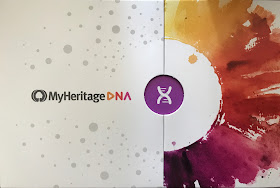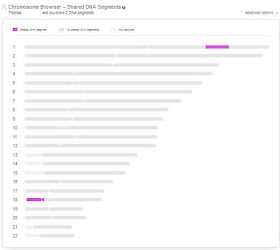I began my post Getting started with GEDmatch with the following discussion:
_________________________________________________________________
There are two very important items for using DNA testing for family history.
- Documented family tree. A documented family tree contains proof of family relationships including copies of birth and marriage records, census records, etc.
- Documented DNA. Documented DNA includes a chromosome browser to prove family DNA relationships. To learn more about the importance of chromosome browsers and how to use them, please see What is the big deal about a Chromosome Browser?
You may have heard the saying, "Genealogy without documentation is mythology." I'd like to also say, "DNA without a chromosome browser is mythology."
It would be wonderful if the documented family tree and the chromosome browser were together in one location.
__________________________________________________________________
A documented family tree and documented DNA has not been available at any of the major DNA testing companies. Until now.
MyHeritage tools
MyHeritage has had documented family trees for years. For the past few years, it has been offering autosomal DNA tests. But it was on January 11, 2018 that MyHeritage finally offered the essential chromosome browser. See Major Updates and Improvements to MyHeritage DNA Matching.
Let's examine the new MyHeritage system.
Your DNA matches
Log into your MyHeritage account. Click the DNA tab, then select DNA matches from the menu.
You will see a list of people who share common DNA segments with you. Here is one of my matches.
Even though there is a link to "View Tree", it is best to click Review DNA Match. We want to see what information is shared between my match Thomas ("Tom") and me.
I contacted this person, and I know that both Tom's and my kit were transferred from Ancestry DNA. So we will be comparing two Ancestry DNA kits with MyHeritage tools.
Click "Review DNA match." You will see everything on one page.
Common surnames
If you and your match have any common surnames in your trees, they will be shown. My ancestors appear on the left, and my match's ancestors appear on the right. This is one of the common surnames:
Common DNA matches
In the next section you will see a list of common DNA matches. These are some of the people who appear on Tom's match list and on my match list.
Family Trees
You can see both your own and your match's family tree so that you can easily compare the two. Click on the "You" tab to see your tree.
This is a portion of Tom's family tree.
In our match's family tree, we are looking to find ancestors who are also in our family tree. The common ancestors that Tom and I share are Jonathan Gragg and Mary Mullins.
By comparing the two family trees, we accomplish two things:
- We can find our common ancestors, and use the chromosome browser to find DNA segments that we may have inherited from those ancestors.
- We can enhance our family tree if we find ancestors that are missing from one of the trees. For example, in the second family tree there are no parents for Jonathan Gragg. We can click on Jonathan Gragg to begin exploring records that could verify that his parents are Henry Gragg and Elizabeth Jones.
Below the family trees, you will find a section for common ethnicities [not shown], then we get to the chromosome browser.
MyHeritage chromosome browser
The chromosome browser shows DNA segments that are shared between you and your match.
By comparing family trees, I have determined that the only common ancestors shared by Tom and me are Jonathan Gragg and Mary Mullins. So I assume that we inherited the above two segments from either Jonathan or Mary, or we inherited one segment from each of them. I cannot be sure of any of this yet.
When you click on a segment in the chromosome browser, you will see segment details including the exact position on the chromosome and the size of the shared segment stated in centiMorgans (cM).
How valid are these DNA segments?
I cannot be certain that we inherited these common segments from Jonathan or Mary, or if there is another common ancestor that we have not yet found.
I can get more evidence by comparing DNA with
other descendants of this couple to see if they also share the same
segments.
MyHeritage does not yet allow us to compare more than one person in the chromosome browser. [Update: You can now compare multiple people in the MyHeritage chromosome browser. It's fantastic!] Several descendants of Jonathan and Mary have been DNA tested. We can see their results in the GEDmatch.com chromosome browser to compare it to Tom's results in the MyHeritage chromosome browser.
First, I can compare my DNA results with Tom's DNA results and display them in the GEDmatch chromosome browser. The shared segment on Chromosome 1 is shown in the GEDmatch and MyHeritage chromosome browsers.
GEDmatch chromosome browser
MyHeritage does not yet allow us to compare more than one person in the chromosome browser. [Update: You can now compare multiple people in the MyHeritage chromosome browser. It's fantastic!] Several descendants of Jonathan and Mary have been DNA tested. We can see their results in the GEDmatch.com chromosome browser to compare it to Tom's results in the MyHeritage chromosome browser.
First, I can compare my DNA results with Tom's DNA results and display them in the GEDmatch chromosome browser. The shared segment on Chromosome 1 is shown in the GEDmatch and MyHeritage chromosome browsers.
However, notice that there is a small shared segment on Chromosome 4 that is not reported by MyHeritage.
Below are chromosomes 9-22. The matching segment on Chromosome 18 is also shown at MyHeritage.
Now let's compare two other descendants of Jonathan and Mary, and put them in the chromosome browser with Tom.
All three descendants share a segment with me on Chromosome 1 and Chromosome 18. Chromosome 18 is shown here:
What about Chromosome 4? Tom and one cousin share matching segments with me on chromosome 4, but they are different segments. Only Tom has the small segment on line 2 of Chromosome 4. Although this segment is slightly larger than 8cM, it is not shown by MyHeritage.
Because only Tom has this segment, it could a coincidental match [called IBS or Identical By State] instead of a segment inherited from the common ancestor [called IBD or Identical By Descent]. It may have been correctly rejected by MyHeritage.
How about this match on Chromosome 6? All three cousins share this segment with me on Chromosome 6, but this segment is too small to be considered a shared segment by MyHeritage.
It appears that MyHeritage is showing only segments in its chromosome browser that seem to be high-confidence shared DNA segments.
MyHeritage allows you to transfer your raw DNA data file from other DNA companies. You can do this for free.
Below are chromosomes 9-22. The matching segment on Chromosome 18 is also shown at MyHeritage.
Now let's compare two other descendants of Jonathan and Mary, and put them in the chromosome browser with Tom.
All three descendants share a segment with me on Chromosome 1 and Chromosome 18. Chromosome 18 is shown here:
What about Chromosome 4? Tom and one cousin share matching segments with me on chromosome 4, but they are different segments. Only Tom has the small segment on line 2 of Chromosome 4. Although this segment is slightly larger than 8cM, it is not shown by MyHeritage.
Because only Tom has this segment, it could a coincidental match [called IBS or Identical By State] instead of a segment inherited from the common ancestor [called IBD or Identical By Descent]. It may have been correctly rejected by MyHeritage.
How about this match on Chromosome 6? All three cousins share this segment with me on Chromosome 6, but this segment is too small to be considered a shared segment by MyHeritage.
It appears that MyHeritage is showing only segments in its chromosome browser that seem to be high-confidence shared DNA segments.
Add notes
When you have found shared DNA from common ancestors, you can include this information in the notes on your DNA match list.
Using the chromosome browser with transferred kits
MyHeritage allows you to transfer your raw DNA data file from other DNA companies. You can do this for free.
However, you might want to be cautious about using the chromosome browser with transferred DNA because the major DNA companies do not all test the same locations on your chromosomes.
To make these other DNA results compatible with MyHeritage DNA results, MyHeritage uses something called "imputation." See Major Updates and Improvements to MyHeritage DNA matching. For another opinion on imputation, see Concepts - Imputation.
When MyHeritage fills in your DNA gaps by imputing your results, it is not necessarily reflecting your DNA. It is reflecting what your DNA probably should be.
However, by comparing DNA segments of multiple matches in the chromosome browsers where imputation is not used, MyHeritage appears to be fairly accurate.
MyHeritage has already announced the plan to allow us to compare two or more people in the chromosome browser. This will allow us to see the shared DNA segments inherited by multiple descendants of a common ancestor.
If you have tested with another DNA testing company, you can download your Raw DNA Data and upload it to MyHeritage.
When MyHeritage fills in your DNA gaps by imputing your results, it is not necessarily reflecting your DNA. It is reflecting what your DNA probably should be.
However, by comparing DNA segments of multiple matches in the chromosome browsers where imputation is not used, MyHeritage appears to be fairly accurate.
Upcoming enhancement
What is the next step?
This is especially important if you tested with Ancestry DNA, because Ancestry is the only major DNA testing company that does not provide a chromosome browser. There is currently no charge for uploading your DNA results to MyHeritage.
You can also download your family tree from other sites and upload it to MyHeritage. Again, this is free!
For step-by-step instructions on downloading your DNA and your family tree, see Getting started with GEDmatch.
If you have compared your ancestry in the new MyHeritage chromosome browser, you can reconstruct your ancestor's DNA.
See Using DNA Painter to reconstruct ancestral DNA
If you tested with MyHeritage, you will also want to submit your MyHeritage results to GEDmatch, See How to use GEDmatch - Part 1 and How to use GEDmatch - Part 2.
The new MyHeritage DNA system is pretty great. With a few enhancements, it will be incredible. Here's my response to the new chromosome browser--I immediately ordered a MyHeritage DNA kit for my mother.
You can also download your family tree from other sites and upload it to MyHeritage. Again, this is free!
For step-by-step instructions on downloading your DNA and your family tree, see Getting started with GEDmatch.
If you have compared your ancestry in the new MyHeritage chromosome browser, you can reconstruct your ancestor's DNA.
See Using DNA Painter to reconstruct ancestral DNA
If you tested with MyHeritage, you will also want to submit your MyHeritage results to GEDmatch, See How to use GEDmatch - Part 1 and How to use GEDmatch - Part 2.
MyHeritage now has the essential DNA tools.
The new MyHeritage DNA system is pretty great. With a few enhancements, it will be incredible. Here's my response to the new chromosome browser--I immediately ordered a MyHeritage DNA kit for my mother.
 |
| MyHeritage DNA kit |
 |
| Mom swabbing her cheek while reading a book |















Linda,
ReplyDeleteYour comment about MyHeritage not providing a pedigree view of your pedigree isn't entirely true.
Admittedly you can't see yours and your match's side by side but you can toggle between them by clicking the you or (match name) tab above the pedigree view.
You are correct. I have revised the blog. Thank you!
ReplyDelete